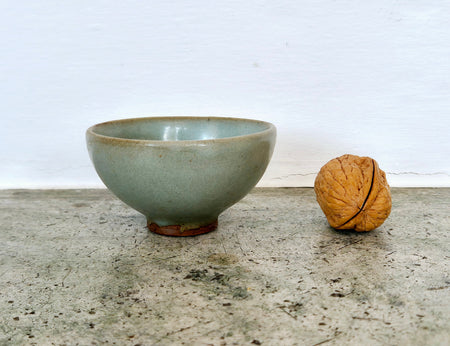Jun ware

Jun wares are characterized by its heavy bodies and thick bluish glazes. They were mainly produced in today's Yuzhou and Linru counties in Henan province, but also in Hebei and Inner Mongolia. Yuzhou is situated near Juntai, hence the kiln-name “Jun”. Production is thought to have started in late 11th-early 12th century and continued into the Ming dynasty. Jun ware has become famous and admired for its glazes which can vary from green-blue to blue-white to sky-blue to lavender.
The Jun kiln primarily produced everyday vessels such as bowls, plates, washers, jars, censers, and pillows. Most of these items were glazed in a sky-blue color with opalescent hues, while some were adorned with splashes of red or purplish-red. However, vessels glazed in rose-violet or begonia-red were more rare. Due to their utilitarian nature, these vessels were commonly referred to as "Minjun."
The grayish-green glaze, colored by ferric oxide, has a long history in traditional high-temperature firing in China. Craftsmen at the kiln introduced elements like phosphorus and titanium into the glaze, resulting in an opacifying enamel layer and a sky-blue color after firing in a reducing atmosphere. This type of ware came to be known as "Jun glaze". Scientific tests have shown that Jun glaze exhibits typical "liquid-liquid" phase separation, creating countless spherical particles and bubbles in a continuous glass medium. This causes incident light to scatter, giving the glaze an opaque appearance and a sky-blue opalescence.
One notable characteristic of Jun ware is the phenomenon of copper red flambe glaze. Initially accidental, this effect occurs when various metal oxides contained in the glaze material react during firing. Due to its coluorful and natural texture, it became a sought-after decoration. Jun ware flambe can be categorized into two types: local flambe, where copper oxide pigment is applied to specific areas of the sky-blue glaze to create purplish-red splashes, and overall flambe, where copper oxide is mixed into the glaze, resulting in variegated visual effects without distinct boundaries between colors.
Jun porcelain vessels were highly popular and influenced the production of vessels in Northern kilns in provinces like Henan, Hebei, and Shanxi, as well as several kilns in the south, such as those in Zhejiang Province. Products from these kilns were also widely traded as everyday commodities.
In 2001, archaeological excavations unearthed kiln site remnants at Hebeidi and Liujiamen in Shenhou town, Yuzhou. Based on these findings production was divided into three periods, spanning from the late Northern Song through early Jin, the late Jin through early Yuan, and the Yuan period.
During the earliest period, production consisted of small vessels often fully glazed with miniature foot supports. These wares predominantly exhibited a pale bluish glaze, with some adorned with large red splashes. Additionally, this period introduced wares with sky-blue glazed interiors and purplish-red exteriors.
As the late Jin dynasty approached, Jun wares experienced a decline in quality, with many pieces exhibiting incomplete glazing and thicker walls. Despite this, vessels gradually increased in size, and the number of red splashes on exteriors increased.
By the Yuan dynasty, Jun ware pieces became notably larger, with thick walls and a weightier feel. Glazes became thicker and more prone to flowing during firing, with an increasing prevalence of red speckles characterizing the glaze appearance.
